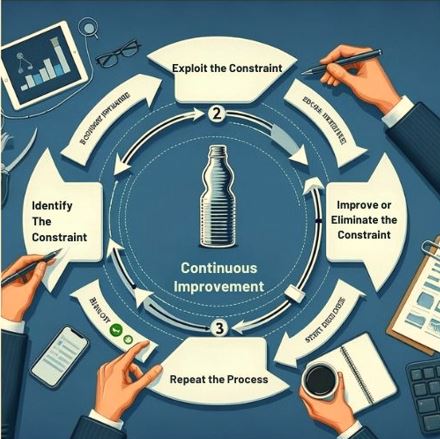The Core Challenge in Marketing
In our extensive experience consulting with B2B and manufacturing companies’ marketing departments, I’ve observed a recurring pattern: typically, there is one pivotal element causing fundamental problems in marketing outcomes. This could be anything from a team member to a process, or even inadequate budgets. The key to unlocking marketing potential lies in identifying and addressing this bottleneck.
Quite often, the bottleneck can surprisingly be found in leadership, particularly when a marketing department manager is reluctant to delegate responsibilities and authority to their team. This reluctance to relinquish control can stifle creativity, slow down decision-making processes, and ultimately hamper the effectiveness of the entire marketing operation.
These types of bottlenecks can also manifest in the form of an underperforming salesperson who might be consuming a disproportionate amount of the budget without delivering commensurate results. This scenario not only strains financial resources but can also skew the strategic focus of the marketing efforts. Recognizing and addressing such leadership and personnel bottlenecks is crucial for fostering a more dynamic, efficient, and responsive marketing team. By identifying these key constraints, whether they lie in management styles or team performance, and strategically addressing them, the path to a more effective and successful marketing operation becomes clear.
Furthermore, a closer examination of marketing strategies and processes often reveals hidden constraints that are not immediately apparent. For example, a well-intentioned but outdated marketing strategy could be limiting the potential reach and impact of campaigns. In the dynamic field of digital marketing, where trends and technologies evolve rapidly, staying agile and adaptable is key. By applying the Theory of Constraints, marketing departments can not only identify these hidden issues but also prioritize them for improvement, ensuring that their strategies are as effective and forward-thinking as possible.
What is the Theory of Constraints (TOC)?
Expanding on the Essence of TOC
The Theory of Constraints (TOC), a concept introduced by Dr. Eliyahu Goldratt, revolutionized the way we think about problem-solving within complex systems. This methodology zeroes in on the most significant limiting factor, often a bottleneck, within any process, and aims to systematically improve or eliminate it. TOC is not just a set of tools; it’s a mindset that encourages continuous improvement and a strategic focus on what truly hampers a system’s performance. It’s applicable across various fields, from manufacturing to healthcare, and has profoundly influenced modern management practices.
The Flexibility and Adaptability of TOC
What sets TOC apart is its versatility and adaptability to different environments and challenges. It’s not just about finding problems but about finding the right problems to solve. In a manufacturing context, this could mean identifying a slow production line or a marketing strategy that’s not delivering the expected results. TOC teaches us to look beyond the symptoms of inefficiencies and delve into their underlying causes, providing a clear path to more effective and streamlined operations.
The Big Idea: Identifying and Tackling the Bottleneck
The Central Concept of the Bottleneck
At the heart of TOC is the concept of the bottleneck. In every process, there is a point that limits the flow and efficiency of the entire system. Identifying this bottleneck is crucial because improvements made elsewhere won’t significantly impact overall performance if the bottleneck remains unaddressed. In marketing, this could be an outdated digital strategy or a gap in market research. Focusing on these bottlenecks ensures that efforts and resources are directed where they will have the most significant impact.
A Strategic Approach to Improvement
Addressing the bottleneck isn’t just about quick fixes; it’s about strategically aligning resources and efforts to create lasting change. It’s an acknowledgment that not all parts of a system are equal in terms of their impact on the overall goals. This targeted approach helps companies avoid the common pitfall of spreading their efforts too thinly across multiple areas, leading to marginal gains but not substantial improvements.

The Scientific Approach
The Methodology Behind TOC
TOC is grounded in a scientific approach, treating each process as a part of a complex, interlinked system. This methodology encourages a holistic view, where the focus is not just on individual components but on how they interact and contribute to the overall system’s efficiency. By identifying the constraint, TOC provides a clear focal point for improvement efforts, ensuring that changes have a cascading positive effect throughout the system.
Systematic and Analytical Problem-Solving
TOC’s strength lies in its systematic and analytical approach to problem-solving. Rather than relying on intuition or scattered efforts, it offers a structured way to dissect a process, identify constraints, and methodically improve them. This logical approach reduces guesswork and enables more predictable and effective outcomes, making it an invaluable tool in complex operational environments.
The Ultimate Goal: Maximizing Profit
Profit Maximization through TOC
The ultimate aim of applying TOC in any manufacturing setup is to maximize profit, both in the short and long term. This goal is achieved by systematically addressing the constraints that limit a company’s ability to generate revenue and reduce costs. By focusing on the constraint, companies can ensure that their efforts directly contribute to the bottom line, making TOC a powerful tool for financial success.
TOC’s Comprehensive Toolkit
TOC offers a suite of tools and methodologies, such as the Five Focusing Steps, the Thinking Processes, and Throughput Accounting. These tools provide a structured approach to identifying and addressing constraints. They also offer insights into different aspects of the business, from operational processes to financial management, making TOC a comprehensive framework for driving profitability.
The Five Focusing Steps: A Methodology for Improvement
A Cyclical Process for Continuous Improvement
The Five Focusing Steps form a cyclical process that ensures continuous improvement in any system. Starting with identifying the constraint, these steps guide a company through exploiting the constraint with existing resources, aligning other processes to support the constraint, elevating the constraint’s performance, and then repeating the cycle. This ensures that as one bottleneck is resolved, attention is immediately shifted to the next, fostering a culture of ongoing improvement.
Practical Application in Marketing
In the context of marketing, these steps can be applied to streamline campaigns, optimize digital marketing strategies, or improve client engagement processes. By focusing on one critical area at a time, marketing teams can achieve significant improvements in performance and efficiency, leading to better outcomes and higher ROI.
The Thinking Processes: Advanced Problem-Solving
Delving into Complex Systems
The Thinking Processes are a set of tools within TOC designed for dissecting and understanding complex systems. These tools are particularly effective in identifying the root causes of problems, known as Undesirable Effects (UDEs), and systematically addressing them. This aspect of TOC is crucial for marketing departments facing complex challenges, as it allows for a deeper understanding of underlying issues and more effective resolution strategies.
Strategic Implementation in Marketing
In marketing, these processes can be used to analyze consumer behavior, assess market trends, and develop more targeted and effective marketing strategies. By applying the Thinking Processes, marketing teams can move beyond surface-level observations and gain insights into deeper, systemic issues that may be hindering their success.
Throughput Accounting: A New Perspective on Performance Measurement
Redefining Financial Metrics
Throughput Accounting shifts the focus from traditional cost-cutting measures to increasing throughput – the rate at which a company generates money through sales. This approach offers a more holistic view of financial performance, emphasizing revenue generation over mere expense reduction. In marketing, this means prioritizing strategies and campaigns that directly contribute to sales and revenue growth.
Aligning Marketing with Financial Goals
Throughput Accounting aligns marketing efforts with the broader financial goals of the company. It encourages marketing teams to focus on activities that have a direct impact on sales and profitability, such as lead generation, conversion rate optimization, and customer retention strategies. By doing so, marketing departments can demonstrate their direct contribution to the company’s financial health.
Drum-Buffer-Rope: Synchronizing Production
Optimizing Flow and Minimizing Waste
Drum-Buffer-Rope (DBR) is a TOC methodology that synchronizes production to the constraint, thereby optimizing the flow of work and minimizing inventory and work-in-progress. In marketing, this can be translated into synchronizing marketing activities with production capabilities, ensuring that marketing efforts are aligned with the company’s capacity to deliver.
Ensuring Consistent Throughput in Marketing
By applying the DBR concept, marketing departments can ensure that their strategies and campaigns are timed and scaled appropriately, in line with the company’s production constraints. This synchronization helps in maintaining a consistent throughput, avoiding over-promising and under-delivering, and ensuring that marketing efforts are sustainable and effective.
Integrating with Lean Manufacturing
A Synergistic Combination
Integrating TOC with lean manufacturing principles can create a powerful synergy. While lean focuses on waste reduction and efficiency, TOC concentrates on optimizing the constraint. Together, they provide a comprehensive approach to improving overall system performance. In marketing, this integration can lead to more streamlined processes, elimination of wasteful practices, and a focus on activities that directly contribute to company goals.
Enhancing Marketing Efficiency and Effectiveness
By adopting lean principles alongside TOC, marketing departments can enhance both their efficiency and effectiveness. This combination encourages a holistic view of the marketing process, identifying areas where resources can be better utilized and strategies can be refined for maximum impact. The result is a marketing operation that is not only lean and efficient but also strategically aligned with the company’s core objectives.
Leveraging TOC for Marketing Excellence in Manufacturing
In my professional experience with B2B and manufacturing companies, the Theory of Constraints (TOC) has consistently emerged as a pivotal tool for enhancing marketing efficacy. My interactions with these companies have highlighted a key insight: pinpointing and resolving the primary bottleneck – be it in processes, leadership, or strategy – is crucial for unlocking marketing potential.
TOC has illuminated the importance of targeted improvement. The concept of zeroing in on and addressing the bottleneck is more than a technique; it’s a paradigm shift. The scientific approach of TOC has demonstrated how optimizing complex systems can lead to efficiency and, in turn, maximized profits.
The methodologies within TOC, such as the Five Focusing Steps, the Thinking Processes, and Throughput Accounting, have been instrumental. They have offered a systematic approach to identify constraints and enhance them methodically. In marketing, these methods have refined strategies, streamlined campaigns, and ensured alignment with the company’s broader objectives.
Furthermore, the integration of TOC with lean principles has created a powerful synergy, leading to more efficient processes while keeping a strategic focus on key constraints. This has transformed marketing departments into entities that are not only lean and efficient but also highly effective and strategically attuned to the company’s goals.
I’ve witnessed firsthand how TOC is not merely a theoretical concept; it’s a practical, impactful tool that can redefine the marketing landscape within manufacturing companies. It compels us to look deeper, to identify the true impediments to success, and to address them decisively. This concentrated approach to problem-solving and ongoing improvement is what can truly unlock the full potential of a marketing department in the manufacturing industry or other B2B environments.
We need to consider how the Theory of Constraints offers a pathway to marketing excellence. By understanding and applying its principles, marketing departments in manufacturing companies can not only surmount their constraints but also pave the way for innovation, efficiency, and significant growth in market influence and profitability.










